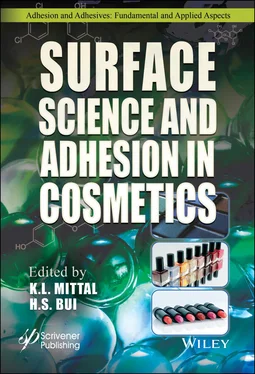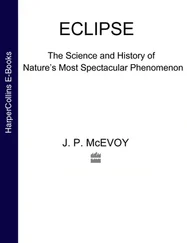4 Chapter 4 Table 4.1 Ingredients used in nail lacquers are listed here with their typical c...Table 4.2 Parameters obtained using Cross model fits (see Figures 4.5–4.7) to th...
5 Chapter 5Table 5.1 Silicone shorthand notation [49, 56].
6 Chapter 6Table 6.1 ToF-SIMS intensities (a.u.) of the 2 peaks relating to 18-MEA on natur...Table 6.2 Average elemental composition measured on hair surface (atom %).Table 6.3 Elemental composition measured in 3 positions along the hair length (a...Table 6.4 Chemical forms of each individual element along with the quantitative ...Table 6.5 Chemical forms of the carbon atom.Table 6.6 Chemical forms of the oxygen atoms.Table 6.7 Chemical forms of the nitrogen atoms.Table 6.8 Chemical forms of the sulphur atoms.Table 6.9 Concentrations of chemical groups on the hair surface determined from ...Table 6.10 Wetting properties of human hair by means of dynamic contact angle me...Table 6.11 Cuticle presence in different types of commercial hair swatches.
7 Chapter 8Table 8.1 Comparison of AFM with peer microscopy techniques.
8 Chapter 9Table 9.1 Comparison of secondary ion mass spectrometers [10, 11].
9 Chapter 10Table 10.1 Contact angle values of water on treated formulations where TCS is tr...Table 10.2 Contact angle values of mineral oil on treated formulations where TCS...Table 10.3 Effect of treatment on mascara performance where TCS is triethoxycapr...Table 10.4 Dyes used in cosmetics (Adapted from [34]).
10 Chapter 11Table 11.1 Characteristics of hexadecane unduloids on stainless steel wires.
11 Chapter 13Table 13.1 Assignment of Raman bands for hair according to the work performed by...Table 13.2 Model composition of a hair conditioner according to Ref. [37]. q.s: ...
12 Chapter 14Table 14.1 Chemical compositions of non-aqueous dispersions.Table 14.2 Molecular weight and Polydispersity Index (PI) determined from SEC fo...Table 14.3 Particles size by DLS for NAD – 1, NAD – 2, NAD – 3.Table 14.4 Glass transition temperatures T gmeasured by DSC and estimated from F...Table 14.5 DMA Results for Non-Aqueous Dispersions (NADs).Table 14.6 Mechanical properties of the three NAD poly(acrylate) copolymers.Table 14.7 Liquids used in surface free energy (SFE) determination by contact an...Table 14.8 Surface Free Energy of the NAD films determined from OWRK model.Table 14.9 Results on Sebum and water sensitivities by the drop test for 3 NAD f...Table 14.10 Results of wear and tack measurements for three NAD films on two sub...Table 14.11 Simple formulations for in-vitro evaluations of the three NAD versio...Table 14.12 Results of oil/water resistance, tack and adhesion of the three NAD ...
13 Chapter 15Table 15.1 Different types of inorganic pigments used in long-wear cosmetics.Table 15.2 Most commonly used organic lake pigments in long-wear cosmetics.Table 15.3 Examples of wetting agents used in color cosmetics.Table 15.4 Most common surface treatments of pigments and fillers used in long-w...Table 15.5 The most used surface treatments in the market for long-wear color co...Table 15.6 Most frequently used fillers for long-wear cosmetics.Table 15.7 Most frequently used surface treated pigments in long-wear cosmetics.Table 15.8 Most frequently used fillers in long-wear liquid foundations.Table 15.9 Examples of long-wear foundations using MgO and Mg stearate to cause ...Table 15.10 Typical fillers used in long-wear powders.Table 15.11 Commercially available fluorinated pigments and fillers.Table 15.12 Typical surface treatments of organic and inorganic pigments used in...Table 15.13 Surface free energy of commonly treated pigments and fillers and sur...Table 15.14 Most frequently used fillers in long-wear lipstick.Table 15.15 Some examples of commercially available Black 2 dispersions used in ...
14 Chapter 16Table 16.1 Summary of skin surface free energy values on volar forearm and foreh...Table 16.2 Young’s modulus determined in vivo using various methods for differen...Table 16.3 Mean skin surface texture parameter Sa (in micrometers) for 3 age gro...Table 16.4 Ingredient analysis of several long-wear liquid foundations launched ...Table 16.5 An exemplary long-wear liquid foundation formulation disclosed in pat...Table 16.6 Key physical parameters of volatile fluids commonly used in liquid fo...Table 16.7 Commonly used cosmetic fluids in long-wear foundations.Table 16.8 Commonly used pigment surface treatment chemistries.Table 16.9 Commonly used silicone film-formers in color cosmetics.Table 16.10 Examples of fillers commonly used in long-wear liquid foundations an...
15 Chapter 17Table 17.1 The differences between Asian (Korean), Japanese and Caucasian(women)...Table 17.2 Typical ingredients in a commercial washable mascara.Table 17.3 Typical ingredients in a commercial waterproof mascara.Table 17.4 Typical ingredients in a smudgeproof mascara [24–26].Table 17.5 Typical commercial long-wear mascara products from 1 day to 4 days we...Table 17.6 Long-wear mascara products with 4-week wear or longer.Table 17.7 Summary of test methodologies for long-wear and semi-permanent mascar...Table 17.8 Example of mascara composition containing MQ resin as a topcoat for s...Table 17.9 Mascara composition containing rosin ester for semi-permanent mascara...
16 Chapter 18Table 18.1 Examples of evolution of lipstick formulations and features from 1990...Table 18.2 Example of a questionnaire [41].Table 18.3 Lip products sensory evaluation protocol, including the criteria defi...Table 18.4 Viscosity measurements and classification in sensory groups of oils [...
1 Chapter 1 Figure 1.1 Structure of the MQ resin used to enhance formulation adhesion [2]. Figure 1.2 Commercially available examples of long-wear lipsticks. Figure 1.3 (a) The anatomical landmarks of the lips [15] (b) Histological sectio... Figure 1.4 Keratin assembly in the different layers of keratinized vs. non-kerat... Figure 1.5 Lip roughness score [40]. Figure 1.6 Wear assay results indicating satisfactory (left) and unsatisfactory ... Figure 1.7 Lipstick stretch test results indicating no cracking (left) and sever... Figure 1.8 DSC profiles of lipstick formulation samples A-D [61]. Figure 1.9 Comparison of 3 lipsticks demonstrating high formulation transfer (A)...
2 Chapter 2 Figure 2.1 Order of crystallization and melting temperatures (T cand T m) of natu... Figure 2.2 Dependence of melting enthalpy on esters component for natural waxes ... Figure 2.3 DSC thermogram of an oil-wax gel system. Figure 2.4 Lipstick sample preparation for SEM investigation. Figure 2.5 Hardness of lipstick structure (containing 15% PE wax) as a function ... Figure 2.6 DSC thermograms of 15% PE wax in low viscosity (LV) HPIB and high vis... Figure 2.7 Effect of oil viscosity on the initial crystallization temperature Tc... Figure 2.8 Effect of HPIB oil viscosity on the relative crystallinity X cduring ... Figure 2.9 Effect of HPIB oil viscosity on the melting peak temperature Tm of 15... Figure 2.10 Effect of the % relative crystallinity X c(from wax melting) on the ... Figure 2.11 SEM micrographs of PE wax-oil lipsticks at fixed 15% PE wax in hydro... Figure 2.12 Effect of oil relative permittivity on the hardness of wax-oil lipst... Figure 2.13 DSC thermograms of 15% PE wax in polar oils (esters) during (a) cool... Figure 2.14 Effect of relative permittivity (polarity) on the relative crystalli... Figure 2.15 Effect of relative permittivity (polarity) on the wax melting peak T... Figure 2.16 Effect of oil viscosity on the melting temperature Tm of PE wax crys... Figure 2.17 Effect of oil viscosity on the hardness of lipstick structure contai... Figure 2.18 Effect of the relative crystallinity X c(%) obtained from crystal me... Figure 2.19 SEM micrographs of PE wax-oil lipsticks at fixed 15% PE wax in ester... Figure 2.20 Effect of PE wax amount on hardness of the HPIB-wax system (HPIB vis... Figure 2.21 Effect of PE wax amount on the (a) cooling and (b) heating curves of... Figure 2.22 Effect of PE wax amount on the melting temperature Tm in HPIB oil wi... Figure 2.23 Effect of PE wax amount in selective viscosity oils on the hardness ... Figure 2.24 Effect of the thickness of deposit on lipstick hardness on Bioskin. Figure 2.25 Effect of oil polarity and oil viscosity on sensorial perception (S+...
Читать дальше












